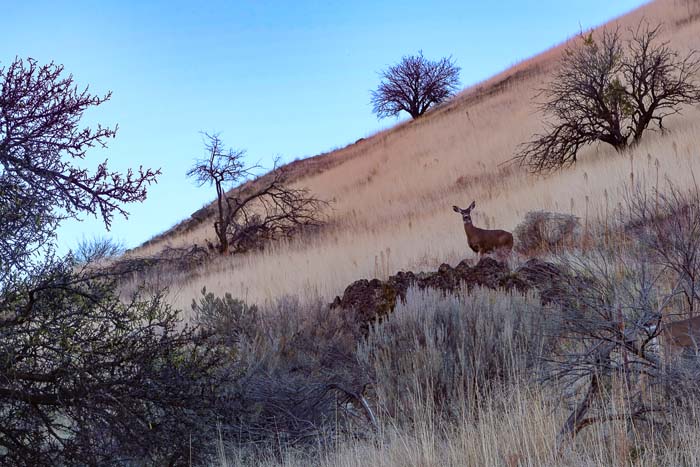ODFW Mule Deer Management Plan addresses predators, climate change impact
Published 11:00 am Tuesday, January 30, 2024

- Mule deer dot the landscape in Eastern Oregon. In 2022, the Oregon Department of Fish and Wildlife estimated the mule deer population at 162,600 animals. It’s a significant drop since mule deer numbers peaked at 306,000 animals in 1980.
LA GRANDE — The future of mule deer in Oregon, like it is on many wildlife fronts, is filled with intrigue and uncertainty.
Trending
This much appears certain, though — wolves will have little impact on the short-term future of mule deer in this state.
That is one of the conclusions one can draw from reading a draft of the Oregon Department of Fish and Wildlife’s draft of its proposed Mule Deer Management Plan. ODFW officials will discuss and take public input on the plan during a Wednesday, Feb. 7, program in La Grande. The program will run from 6:30-8 p.m. at the Forestry and Range Sciences Lab, 1401 Gekeler Lane.
The management plan states that wolves do not appear to be a significant threat to Oregon mule deer for two reasons. One is that there are only 178 wolves in Oregon, based upon the ODFW’s 2022 count, the most recent census it has released. A second reason is wolves appear much more interested in hunting elk than deer, according to preliminary studies in Oregon.
Trending
One study indicates that 62% of the diet of wolves in Oregon is elk and that just 2% of it is mule deer, according to the ODFW Mule Deer Management Plan.
“Given the relatively small population of wolves in Oregon, compared to cougars, and the apparent selection for elk, wolves do not appear to be a significant source of mortality in Oregon at the present time,” the proposed Mule Deer Management Plan said.
The plan states that radio collars may be later placed on mule deer in Northeast Oregon to give biologists a better idea of how often they are preyed upon by wolves.
Cougars remain the chief predator
The Mule Deer Management Plan, when discussing predators, says cougars continue to have the greatest potential impact on mule deer populations. The report states that cougars take all ages of mule deer and that attacks by cougars are the greatest threat female mule deer face. The report also states the biggest threat to mule deer are female cougars with older kittens.
“Females will kill more often to support dependent offspring,” according to the document.
One strategy the Mule Deer Management Plan recommends for consideration in the future for addressing mountain lion predation is the creation of cougar removal areas. These would be sites where cougar harvests by hunters are not meeting the ODFW’s objectives. An effort to remove as many cougars as possible would be taken by the ODFW in these areas. The creation of cougar removal areas would have to be approved by the Oregon Fish and Wildlife Commission.
Climate change and its potential impact on mule deer habitat is also addressed in the plan. The plan highlights that the reduced snowpacks expected to be brought on by climate change would boost over-winter survival of mule deer but many negative impacts would follow, including less water runoff in the spring that will reduce the vegetation available to does raising fawns.
In addition, the plan states that anticipated hotter temperatures will reduce the growing season for vegetation, giving mule deer less of an opportunity to eat enough to build up fat reserves they need to survive winter months.
Other impacts
The negative impact of climate change is why the management plan suggests that the ODFW and land managers work together on habitat improvement projects, including selective forest thinning designed to allow sunlight to reach the forest floor to increase the abundance of vegetation.
The plan also addresses the impact fencing for livestock containment, crop protection and property boundaries is having on mule deer.
“Many fences represent a significant barrier to mule deer migration and movement. Studies show that mule deer commonly alter behaviors in response to fences,” the management plan states.
Fences can cause mule deer of all ages to suffer serious injuries while attempting to jump over them. The Oregon Mule Deer Management Plan recommends that landowners and volunteers work together to remove unnecessary fences and to retrofit fences ”with wildlife friendly” features that makes it easier for deer to move about.
The many other things addressed in the plan include the declining mule deer population in Oregon. In 2022, the Oregon Department of Fish and Wildlife estimated the mule deer population at 162,600 animals. It’s a significant drop since mule deer numbers peaked at 306,000 animals in 1980.
The ODFW’s proposed Mule Deer Management Plan is a revised version of one from 2003. ODFW Communications Coordinator Michelle Dennehy said the new management plan was needed because things have changed greatly over the two decades in wildlife research.
“We know so much more than we did in 2003,” she said.
The Mule Deer Management Plan will not become official until the Oregon Fish and Wildlife Commission votes to approve it. Dennehy said the commission will vote on the plan later this year.









